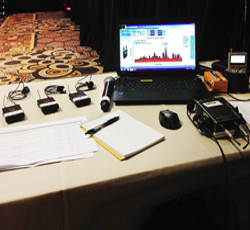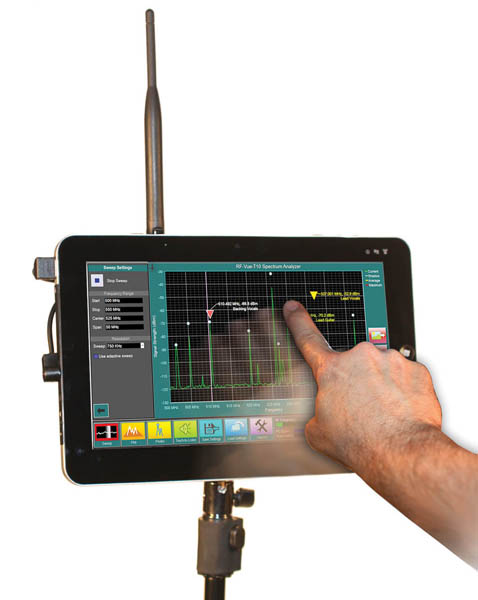
Additional Aspects
And that brings up another concept, which is monitoring. Particularly when using multiple wireless channels, this is a good idea, with many newer systems offering networking and the ability to link receivers together as well as remote monitoring of the system as a whole.
Soundcraft and Shure recently announced a new collaboration that enables native monitoring and control of select Shure wireless systems on Soundcraft Vi Series digital consoles. The new Soundcraft Vi5000 and Vi7000 digital consoles support Shure ULX-D and QLX-D systems as well as AKG DMS800 and WMS4500 systems.
There are some excellent third-party spectrum analyzers available that are also useful in keeping an eye on things. A spectrum analyzer monitors a range of the frequency band that is determined by the user. It sweeps across the range over and over, measuring the strength of the present RF signals and displaying the results. Users can see the background noise level as well as their own wireless system signals and any unwanted or unknown signals that may cause interference.
RF Explorer offers a compact, portable spectrum analyzer that’s available in different models depending on the frequency bands the user needs to view. The unit can also interface with a computer for data storage, control and monitoring.
Kaltman Creations offers several handy tools along these lines, including the RF Command center that interfaces with a computer and the portable RF-Vue that interfaces with a tablet allowing the user to walk around and take measurements. The company also offers a nifty unit called the RF-id SOLO, a small frequency counter that can identify the exact frequency a transmitter is operating on as well as confirming power output, which helps in identifying and troubleshooting wireless problems both onsite and back at the shop.
Another way to reduce the potential for problems is to use directional antennas, especially for transmitting with IEMs. Directional “paddle-style” (a.k.a., log-periodic dipole array) antennas can provide up to 6 dB of gain, and Helical antennas can provide up to 10 dB. With receivers, they can reduce the amount of unwanted noise picked up in comparison to an omnidirectional antenna, and offer forward gain that helps when they’re placed at a decent amount of distance from the transmitters.
Being Prepared
Earlier I mentioned the importance of pre-planning. Along with monitoring the airwaves during an event, it’s really the key to a successful show involving wireless systems. Before every event where we’re using wireless, we check to see what transmitters are in the area and if any other wireless systems will be in use. Because we do a lot of work in Las Vegas casinos, it’s not uncommon for an in-house show in a theater that uses dozens of wireless to be located on the other side of the wall from a ballroom.
We also coordinate with the in-house A/V department and any other production vendors working in the building. Once we’ve selected clear frequencies that work well with each other (as well as a bunch of backup frequencies) we monitor the airwaves during the event, checking for potential problems.
Recently we were hired to provide some wireless systems at a general session. It wasn’t huge, just eight wireless mics plus four stations of wireless intercom, but there were more than 200 frequencies in use on three floors of meeting space in the facility.
It could have been a disaster, but fortunately the event manager contracted a wireless coordinator, who made sure all of the frequencies for our event, and the other frequencies in use at the property, all “played nice” together. On our end, I monitored with a spectrum analyzer during rehearsals and on show day, and had a list of backup frequencies we could switch to if needed. With this little bit of attention to the details, we had a great event with no wireless problems over the entire week.
Senior contributing editor Craig Leerman is the owner of Tech Works, a production company based in Las Vegas.

